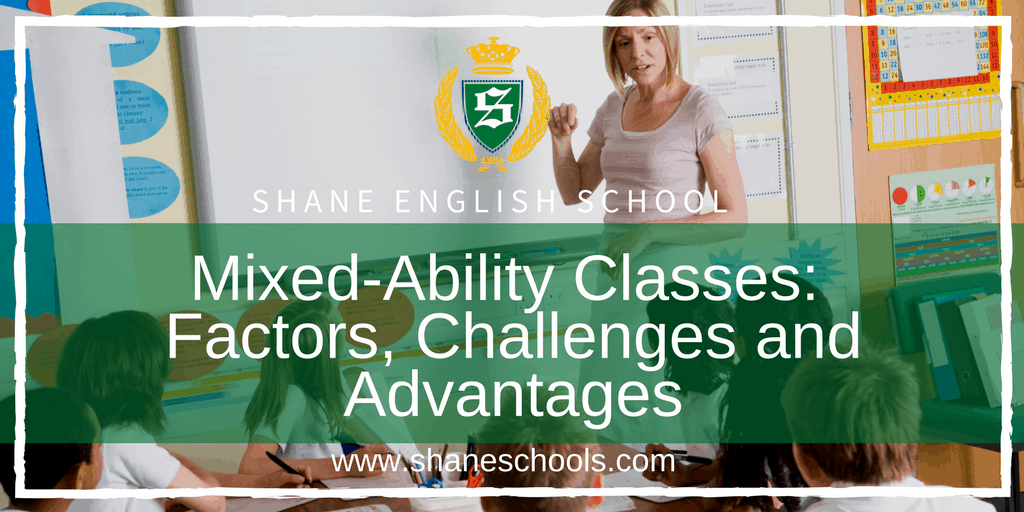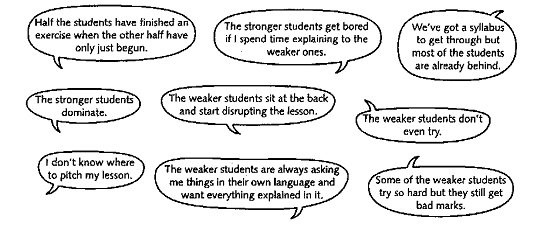As an EFL teacher, it is seldom that you have a class of students who have the same language learning levels. As such, it is well known that mixed-ability classes are the norm and not an exception.
If you are new to teaching, you might be wondering what is meant by a mixed-ability class. A mixed-ability class, also called a heterogeneous class, means that you have students in the same class who have various levels of language proficiency. Mixed-ability and heterogeneous are, to some extent, misleading terms, as no two learners have identical proficiencies, especially in a language learning class. Thus, homogeneous classes cannot and do not exist, and all classes, in fact, are heterogeneous. However, mixed-ability is used to describe those classes where significant gaps are present in learning proficiencies in one, single class, and the weaknesses, strengths, and approaches to learning of the students are notable.
In this article, we will look at factors that affect the ‘mixed-ability-ness’ of your class, possible problems that ESL teachers face, advantages to teaching these classes, and tips and strategies for dealing with these classes (and students).
Mixed-Ability Factors in a Class
There are at least nine factors that can affect learners’ characteristics in a single ESL class. These comprise:
- Maturity and age (Do you have a class in which the students are not just age nine, but ages 17 to 36?)
- Multiple intelligences
- Learning styles (Do you have a class in which some students have auditory learning styles, others have visual learning styles and the remainder of students of kinaesthetic learning styles?)
- Language levels and aptitudes
- Native language (Do you have a class where all the students speak Mandarin Chinese at home, or do you have a class in which the students speak Cantonese, Italian, German and Russian at home?)
- Learner autonomy
- Reason for learning English
- Cultural background
Common Teacher Problems in These Classrooms
There are numerous problems and challenges that EFL teachers will and can face when teaching mixed-ability classes. From the Wits Language School, these are some typical problems:
In addition to these problems above, there are also other challenges that EFL teachers face. One of these is discipline, and this ties in closely with classroom management. This challenge usually occurs when the students in the class feel frustrated; the stronger (or advanced students) may feel that they are not being challenged enough and are not learning as much as they can, while the weaker (or – more politically correct term – less advanced) students feel that the tasks and learning materials are0 too difficult or the teacher does not assist them enough.
Secondly, student participation is another worry. In a mixed-ability class, the teacher will find that the stronger students generally participate more than the less advanced students. This may be due to the shy nature of the less advanced students or because they are very aware that they are not the top students in the class and are scared of getting the answer wrong. Lack of participation can also lead to the less advanced students performing even less (or worse) in class. Ideally, you want all students to participate equally in class; however, this is almost never the case.
The third challenge stems from individual awareness in that the EFL teacher may not be able to follow and track the progress of all the students as closely, and further to this, the teacher might not be able to devote the time and attention needed to less advanced students. In a mixed-ability class, the teacher might find that they spend too much time on the stronger students; an effort should be made to spend more time assisting the less advanced students.
Advantages to Teaching Mixed-Ability Classes
While the challenges and problems associated with mixed-ability classed may seem overwhelming, there are advantages to teaching and learning to manage these classes. Carol Ann Tomlinson, in her book, The Differentiated Classroom: Responding to the Needs of All Learners, might have stated it best: “A secure teacher comes away from today with important questions to puzzle about overnight and the belief that today contains insights necessary for a more effective tomorrow.” ESL teachers are provided with plenty of opportunities in mixed-ability classes to further develop as teachers as they need to embrace different problem-solving approaches to help deal with difficulties faced in the classroom and also experiment with a wide range of teaching approaches to see what works best.
In addition to this, other advantages include the fact that from a mixed-ability class, the teacher can tap into different student experiences, knowledge, and ideas to give interesting student-centered lessons, and in these classes, students can help each other and, by extension, learn a lot from their fellow classmates.
Conclusion
While it may seem daunting to teach mixed-ability classrooms, EFL teachers should instead see it as a challenge and adventure. As a teacher, you will never be able to grow, develop and learn if you only ever had easy classes to teach. Those are, of course, nice and should be appreciated as such, but mixed-ability classes are challenging and they challenge the teacher teaching them. You need to experiment, adapt and problem-solve, all of which will make you an even better teacher.
About the Author
Denine Walters is currently a freelance writer, editor/proofreader, and ESL teacher. Previously, she taught online English lessons to students from all around the world and, before that, she lived and taught English to young learners in Taiwan. In her free time, she likes to read, do scrapbooking and grammar quizzes, and travel.

We're hiring!
With schools around the world, Shane English School always has exciting new opportunities to offer.



